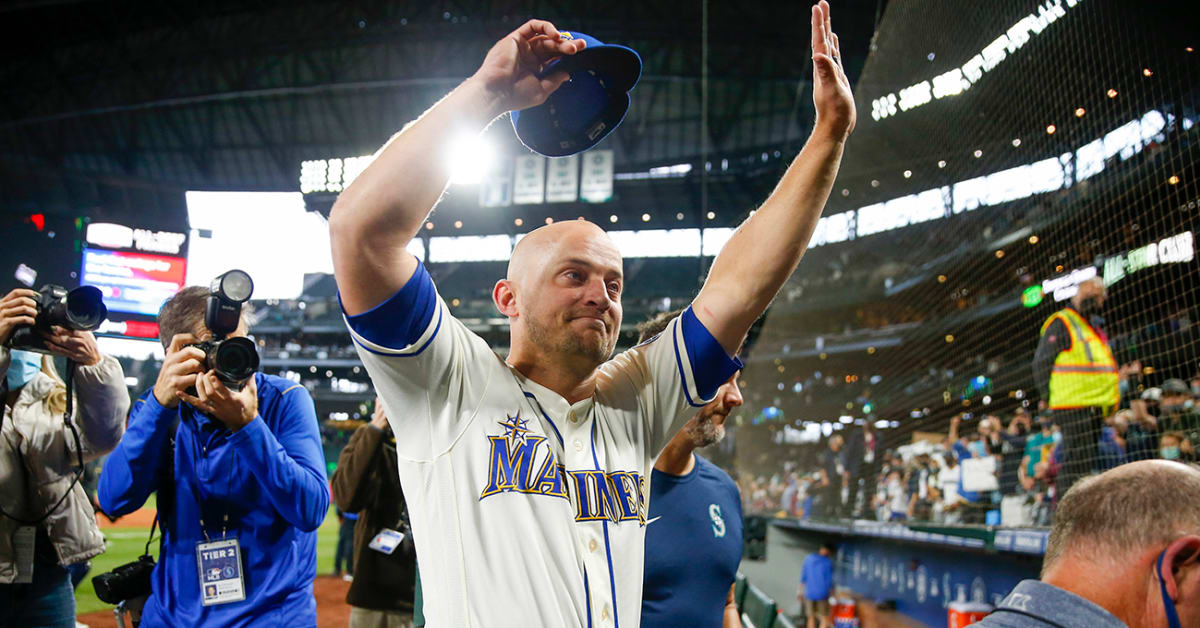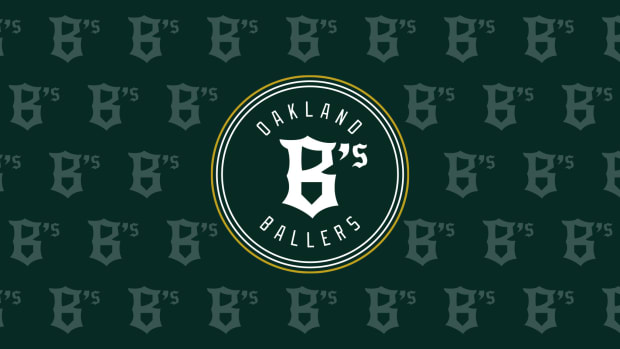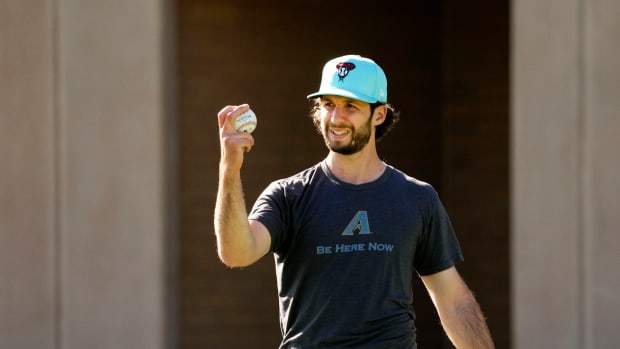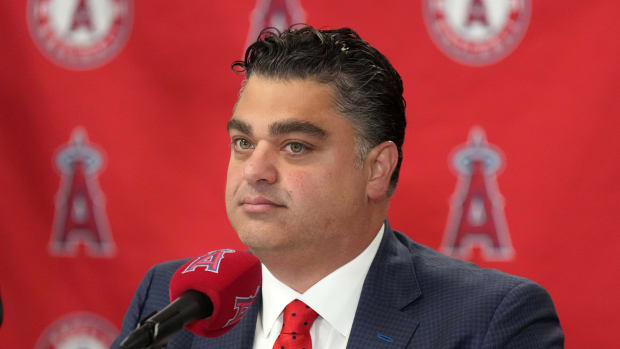Kyle Seager Never Got the Recognition He Deserved
It was perhaps the only way for Kyle Seager to go out. No fanfare. No press conference. Just a short statement from Seager that his wife, Julie, posted on her Twitter account Wednesday.
“Today I’m announcing my retirement from Major League Baseball. Thank you to all of my family, friends and fans for following me throughout my career. It’s been a wonderful ride but I am unbelievably excited for the next chapter of my life.”
As early as this spring, before the season began, Seager was considering retiring at the end of the year. It was already clear he wouldn’t be returning to the Mariners, who were transitioning to their next core of young players and wouldn’t want to pay the aging third baseman for another year if he wasn’t in their long term plans. They gave him a proper sendoff at T-Mobile Park in Seattle on the final day of the season. They removed him during the ninth inning, allowing him one final ovation from the fans for his 11 years with the team.
“I knew I was saying goodbye to baseball at that time,” he told Ryan Divish of The Seattle Times on Wednesday night. “I knew if we got eliminated that would be the last time I played baseball. I knew it was my last at-bats, I knew it was my last ground balls, my last innings. All those thoughts were in my head. I had so many emotions going on that day. My family being out for the pregame pitch was magical. I got very emotional very early in the day!”
On Nov. 2, Seager became a free agent for the first time in his career, when the Mariners declined to pick up his $20 million option for the 2022 season. He turned 34 the next day, but despite his age, he still had plenty left to offer. He’d just played in 159 games and set career highs with 35 home runs and 101 RBIs. Many contending teams could use a veteran lefty bat with power; indeed, he was drawing interest from other clubs before the owners locked out the players on Dec. 2. He was SI's No. 13 ranked free agent heading into the lockout. But his mind was already made up.
All that was left was for Seager to make it official. How and when he did it—via his wife’s tweet during the week between Christmas and New Year’s with MLB shut down—underscores the paradox of his 11-year career. He retired as one of the best players in Mariners history, yet his career will be remembered nearly as much for what he didn’t do.
Despite his consistency, he made just one All-Star team. He never played in the postseason, though he’s certainly not to blame for his franchise’s two decades of ineptitude. He spent most of his career in relative obscurity: first, as one of the best players on a few truly awful teams; next, as one of the core members of a talented team that underachieved; then, as the older brother of Corey, a superstar for the Dodgers who was baseball’s top prospect, a Rookie of the Year and a World Series MVP. Playing in the Pacific Northwest on many non-contenders surely didn’t help to raise his profile. He didn’t shy away from the spotlight, but he was perfectly content to yield it to someone else. Still, he was one heck of a ballplayer, one who deserves our recognition even if he didn’t seek it.
Seager was drafted in the third round of the 2009 amateur draft out of the University of North Carolina, and even then he was playing second fiddle. The Mariners had the second overall pick that year, and took Dustin Ackley, Seager’s Tar Heels teammate. In scouting Ackley, they saw Seager regularly, and they were impressed with his consistency if not blown away by his tools.
“He has a patient approach but doesn’t project to hit for much home run power because of his modest bat speed and flat swing plane,” Baseball America wrote of Seager in his pre-draft scouting report. “Featuring an average arm and impressive agility, he’s an average defender at third, if not a tick above. Scouts who like him see a Bill Mueller type who doesn’t fit the profile but grinds out at-bats and outs in the field. His detractors see him as a safe pick with low upside and a future reserve or utility player.”
Seager hit at every level of the minors, and played consistent defense at multiple infield positions, but there still wasn’t much hype for him. Some thought he was best suited at second base, but that position was being held for Ackley, who MLB.com ranked the the fifth-best prospect in baseball entering 2011.
Both Seager and Ackley made it to the big leagues that year. Ackley had a strong first season but never again reached those heights. He played his last MLB game in 2016, at age 28. Seager was just getting started.
“Everybody loves a prospect,” he told Divish earlier this year. “I was never a prospect.”
Seager wouldn’t have made the Opening Day roster in 2012 if not for injuries to Franklin Gutierrez and Mike Carp, but he took advantage of the opportunity. In 155 games, he hit .259/.316/.423 with 35 doubles and 20 home runs, impressive pop for a kid who wasn’t supposed to have much power in the majors—especially when you consider he played home games at one of the most pitcher-friendly parks in the league.
So began a stretch of remarkable consistency and durability—he played in at least 154 games and hit at least 20 home runs each year from 2012-18. That streak was snapped when he underwent surgery on his left hand during March 2019, prompting his first and only trip to the injured list in his career, and forcing him to miss nearly two months of the season. He finished the year with 23 homers in 106 games. He played in all 60 games during the pandemic-shortened 2020 season and hit .241/.355/.433 with 12 doubles and nine home runs, which works out to a pace of 32 doubles and 24 home runs over a full season.
The 2021 Mariners won 90 games for the first time since 2003, and they did so despite having a –51 run differential and the fourth-worst scoring team (4.30 runs per game) in the American League. Their surprising success was due in part to having a lot of young, talented players who are prone to inconsistency, but it also wouldn’t have been possible without the steady presence of Seager. Mitch Haniger, one of Seattle’s few other veterans but still three years younger than Seager, told Divish that Seager was “a mentor and a friend,” and was brutally honest whenever he was asked for advice.
“He’s not going to tell you: ‘No, it’s OK. You’re doing good,’” Haniger told Divish. “He’ll say you need to get better at this. You need to do this. He’ll always say, ‘I’m here to help you get better.’”
Seager easily could have kept playing. He would’ve been a great addition to playoff contending teams such as the Blue Jays, Yankees and Brewers. The Rangers could’ve made him their next acquisition in their offseason spending spree. Aside from the obvious fit of having him man the left side of the infield with his brother Corey, whom Texas recently signed to a 10-year, $325-million megadeal, Kyle would be an ideal mentor for the many younger Rangers players. All four of those teams would’ve given him a chance to finally reach the playoffs after years of coming up short.
Seager’s closest comparison through his age-33 season, according to Baseball-Reference’s similarity score, is Graig Nettles. That’s not to say Seager was as good as Nettles, an all-time great third baseman who has a pretty compelling Hall of Fame case. Instead, it is interesting to imagine what the next five years of Seager would’ve looked like had he wanted to keep playing. His consistency and durability suggest he could’ve had a slower decline; maybe he could’ve reached milestones such as 400 doubles and 300 home runs.
Playing baseball, though, simply is no longer a priority for Seager. He isn’t interested in legacy chasing. He has three young kids at home, and has made enough money during his career to support his family. Now, the most important thing he can give them is his time.
“My family is growing and I’m missing more and more,” he told Divish Wednesday night, “and that wasn’t something I was willing or needed to do anymore.”
Emma Baccellieri will be doing another mailbag in next week’s newsletter, so if you have a question you would like answered, send it to mlb@si.com, or hit her up on Twitter @emmabaccellieri.
1. THE OPENER
“What could be a better time for reflection than the end of the year? Easy: the end of the year in a game that’s locked out. Here are five things we learned from MLB in 2021…”
That’s Emma Baccellieri in her column from yesterday wrapping up this year in baseball. She takes a look at sticky stuff, stolen bases and the three true outcomes, among other trends of the game.
You can read Emma’s entire column here.
2. ICYMI
MLB Roundtable: New Year's Resolutions by SI MLB Staff
Let's look forward to 2022 with these wishes for the coming season.
Top 10 Moments From the 2021 MLB Season by Nick Selbe
From Shohei Ohtani’s epic to Will Craig’s blunder, these are the events that defined an unforgettable baseball year.
Can MLB’s Biggest Disappointments of 2021 Return to Form? by Will Laws
Anthony Rendon, Cody Bellinger and almost the entire Mets lineup are among the players who had unexpected down years. Will they turn it around?
Can These Stars Repeat Their Surprising Success in 2022? by Nick Selbe
The 2021 campaign saw plenty of unexpected star turns. Will they keep it up?
Nelson Cruz Keeps Booming As Slugger and Humanitarian by Daniela Perez
Baseball’s late-blooming, ageless wonder has remained a feared slugger and generous philanthropist into his 40s.
3. WORTH NOTING from Stephanie Apstein
An 18–8 September brought the Mariners within two wins of ending the longest playoff drought in American pro sports, at 20 years, but the Red Sox and Yankees snuffed out their hopes. As it turned out, that was Seager’s last, best chance to end his own drought: Until he retired on Wednesday, he was the active leader in regular season games played without a postseason appearance (1,480). The players who now take over that title all have ties to the Phillies, who currently sit at 10 years without seeing the playoffs: Philadelphia second baseman Jean Segura (1,230 games), who himself spent two years in Seattle; Phillies catcher J.T. Realmuto (866); and Nationals third baseman Maikel Franco (820).
4. TRIVIA! from Matt Martell
Before we get into this week’s question, here is the answer to the one I asked last Friday.
Last Newsletter’s Question: No player has hit 20 triples in a season since 2007. That year, two players did it; Jimmy Rollins was one of them. Can you name the other?
Answer: Curtis Granderson (23)
This Week’s Question: Kyle Seager is one of four left-handed-hitting third basemen to record five or more seasons with at least 25 home runs. Can you name the other three?
5. THE CLOSER from Emma Baccellieri
If you’d like to mark the new year with a relevant baseball statistic … it’s surprisingly hard! There are zero hitters in MLB history who finished their career with 2,021 or 2,022 hits, and there are zero pitchers who finished with 2,021 or 2,022 strikeouts, or 2,021 or 2,022 innings pitched. The best we can do? Career plate appearances. We’re transitioning from José Tartabull (the only player with 2,021 career PA) to Rich Amaral (2,022). Happy New Year.
That’s all from us today. We’ll be back in your inbox next Friday. In the meantime, share this newsletter with your friends and family, and tell them to sign up at SI.com/newsletters. If you have any questions or comments, shoot us an email at mlb@si.com.






































